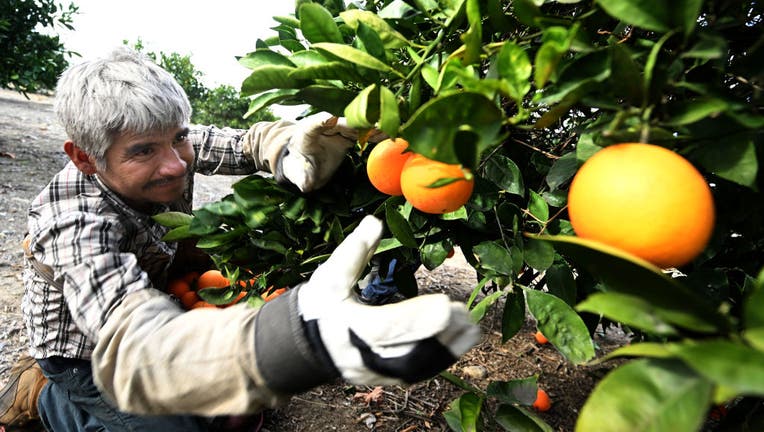Orange juice prices set to stay high as diseases, extreme weather ravage global harvests

Redlands, CA - January 30: A worker removes all the oranges from a tree in a Redlands orange grove for disposal along Lugonia Avenue on Tuesday, Jan. 30, 2024 due to the discovery of the Oriental fruit fly in the area. If left unchecked, the Oriental
MOGI GUACU, Brazil - The price for orange juice could remain high due to the diseases and extreme weather ravaging orange groves in some top-producing countries.
This year’s harvest in Brazil, the world’s largest exporter of orange juice, is likely to be the worst in 36 years due to flooding and drought, according to a forecast by Fundecitrus, a citrus growers’ organization in Sao Paulo state.
"The concern isn't just that the price of juice is going up. The concern is not having the juice," Oscar Simonetti, an orange farmer in Mogi Guacu, Brazil, said.
In the U.S., Florida's already diminished orange production fell 62% in the 2022-2023 season after Hurricane Ian further battered a crop that was struggling due to an invasive pest. Drought also cut Spain’s orange production last year.
RELATED: These US cities now among world's most 'impossibly unaffordable,' report says
Scarce supplies have sent prices soaring. In the U.S., a 12-ounce can of frozen orange juice concentrate cost an average of $4.27 in April, 42% more than during the same month a year earlier, according to government figures.
Those price increases are turning off inflation-weary consumers. Orange juice consumption has fallen 15% to 25% in major global markets — including the U.S. and the European Union — over the last year, according to Rabobank, a Dutch bank that focuses on food and agriculture.
Global orange juice consumption was already declining before the current price hikes due to competition from other drinks and public concern about the amount of sugar in fruit juices. If that trend continues, it should help balance supply with demand and keep prices from rising much further, Rabobank said. But it expects limited supplies will keep prices elevated for some time.
In some markets, orange juice is disappearing from shelves altogether.
Late last year, McDonald’s in Australia removed orange juice from its menu in favor of an "orange fruit drink" that contains 35% orange juice. The company cited short supplies.
The roots of the current supply troubles stretch back decades. In 2005, an invasive bug called the Asian citrus psyllid arrived in Florida, injecting bacteria from its saliva into the state’s orange trees. The bacteria slowly kills the tree by destroying its root systems. There’s no known cure once a tree is infected.
The impact has been devastating. In 2004, before the disease – called citrus greening – hit Florida, the state produced 200 million boxes of oranges. This year, it will produce less than 20 million.
Still, the disease is spreading. Fundecitrus estimates that 38% of Brazil’s orange trees had citrus greening in 2023. Simonetti, the orange farmer, estimates that 20% of his production is affected by greening. Oranges on affected trees don't ripen properly and fall off early, affecting the quality of their juice, he said.
Shifting production to other locations isn’t necessarily an option. California grows oranges, for example, and the citrus psyllid doesn’t fare as well in the state’s climate. But California also doesn’t get the rainfall needed for juicing oranges; its oranges are usually sold for eating, Rogers said.
Another issue impacting orange harvests is extreme weather, which is becoming more common as the world warms due to climate change.
Last year, nine heat waves swept across Brazil, resulting in lower output and poorer fruit quality. This year, the impacts of El Niño have been particularly dramatic, with a historic drought in the Amazon and devastating floods in the southern state of Rio Grande do Sul.
The Associated Press contributed to this report. This story was reported from Los Angeles.

